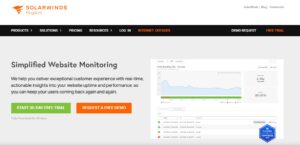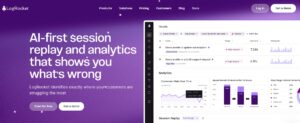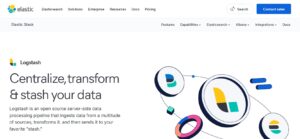AppSignal, a popular APM , provides robust monitoring for Ruby, Elixir, Node.js, Python, and JavaScript applications, offering features like error tracking, performance metrics, and log management. However, it lacks real user monitoring (RUM), synthetic monitoring, self-hosting options.The APM market is expected to grow from 5.64(billion) in 2024 to $12 billion by 2035. Amid this growth, DevOps teams and software developers are seeking robust APM tools that can provide full-stack observability capabilities.
CubeAPM stands out as a top AppSignal alternative due to its affordability, comprehensive feature set, and flexibility. Offering robust support for metrics, traces, logs, and errors, CubeAPM has 800+ integrations and thus seamlessly connects with modern tech stacks, including cloud-native and microservices architectures.
In this article, we break down the top 7 alternatives to AppSignal in 2025, comparing tools based on metrics ingestion efficiency, sampling strategy, pricing transparency, MELT coverage, OpenTelemetry support, and support for flexible deployments.
Table of Contents
ToggleTop 7 AppSignal Alternatives
- CubeAPM
- Dynatrace
- Coralogix
- DataDog
- New Relic
- Sumo Logic
- Better Stack
Why Look for AppSignal Alternatives?
AppSignal is a robust application performance monitoring (APM) tool tailored for Ruby, Ruby on Rails, Elixir, Node.js, Python, and JavaScript, offering features like error tracking, performance monitoring, host metrics, and log management. However, several limitations drive developers and businesses to seek alternatives. Below are the key reasons to explore AppSignal alternatives, supported by direct user quotes and critical analysis.
1. Limited Language and Framework Support
AppSignal’s focus on Ruby, Elixir, Node.js, Python, and JavaScript makes it less versatile for teams using other languages like Java, .NET, PHP, or Go. This restriction can be a significant pain point for enterprises with diverse tech stacks.
A G2 reviewer noted:
“I only wish they supported a few more languages – mainly Rust.”.
2. Lack of (RUM) and Synthetic Monitoring
AppSignal’s absence of dedicated Real User Monitoring (RUM) functionality limits its ability to capture and analyze actual user experiences within applications. RUM tools are essential for tracking end-user interactions, such as page load times, session replays, and client-side errors across different browsers and devices.
This type of monitoring provides critical insights into user behavior, enabling businesses to optimize performance from the user’s perspective. Without RUM, organizations may miss key issues affecting user experience, which can result in customer dissatisfaction or lost revenue. Competitors like CubeAPM, and Datadog offer comprehensive RUM features that provide a deeper understanding of user behavior, helping businesses improve application performance in real-time.
3. Overwhelming and Cluttered User Interface
AppSignal’s user interface, can feel cluttered and unintuitive due to the dense presentation of options and functionalities. This makes it challenging for users to quickly locate specific features or interpret data efficiently, reducing productivity and increasing the learning curve for teams. A cluttered UI is particularly problematic for developers needing actionable insights under time constraints, as it can obscure critical performance or error data.
4. SaaS-Only Deployment
AppSignal’s SaaS-only model lacks self-hosting options, which is a dealbreaker for organizations with strict compliance or data sovereignty requirements. This is a critical issue in the case of AppSignal, and although it boasts compliance with regional laws like GDPR, it comes with additional cost. For instance AppSignal charges $ 99 per month for HIPAA compliance.
Alternatives like CubeAPM, SigNoz offer self-hosted deployments, provide greater flexibility for such teams.
5. Scalability and Pricing Issues
While AppSignal provides predictable pricing, it may not be the most cost-effective solution for organizations, especially those managing high-traffic or large-scale applications. AppSignal’s pricing model is based on the number of requests made to the service, which can quickly become expensive as traffic volume increases. For businesses with rapidly growing user bases, this can lead to significantly higher costs, limiting scalability.
Criteria for Evaluating Alternatives to AppSignal
When assessing alternatives to AppSignal, we considered a blend of technical, operational, and financial factors through an in-depth feature comparison. Our evaluation criteria include:
1. OpenTelemetry & Prometheus Compatibility
Prioritized tools with strong support for OTEL and Prometheus were a key factor. Tools such as CubeAPM, Grafana Cloud, and Coralogix excelled in this area.
2. Cost-Effectiveness & Transparent Pricing
We favored alternatives offering flat or usage-based pricing, transparent data retention policies, and no additional charges for users.
3. Self-Hosting or Data Residency Options
For teams with specific regulatory or infrastructure needs, we prioritized tools that offer on-premises or region-specific hosting, such as CubeAPM, ensuring better data control.
4. Comprehensive MELT Stack Support
An ideal APM solution should support the entire MELT stack—Metrics, Events, Logs, and Traces. We selected tools capable of monitoring everything from infrastructure to RUM (Real User Monitoring) and synthetic tests.
5. Ease of Setup & Operational Simplicity
APM solutions offering quick onboarding, user-friendly UI/UX, and minimal agent deployment were given preference. Tools like CubeAPM and Dynatrace stood out for their simplicity.
6. Advanced Features & AI-Driven Monitoring
DevOps teams value features such as anomaly detection, smart sampling, and AI-powered alerting. These capabilities help identify and address issues early, ensuring continuous application performance.
7. Collaboration & Integration
We emphasized the importance of integrations with popular tools like Slack, Jira, PagerDuty, and GitHub Actions to optimize incident management and streamline DevOps workflows.
8. User Experience & Operational Efficiency
A smooth onboarding process, intuitive dashboards, and low learning curves were vital for developer adoption, ensuring that teams could easily implement and benefit from the monitoring solution.
AppSignal Overview
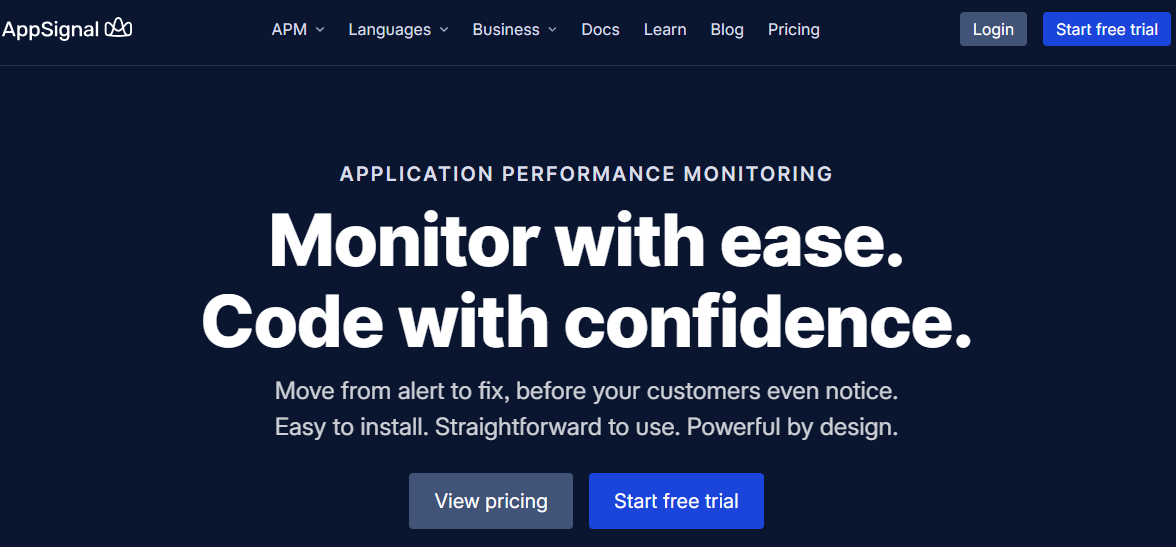
Known for:
AppSignal is recognized for its seamless integration with Ruby on Rails, Elixir Phoenix, Node.js, Python, and JavaScript applications. It provides a unified platform for performance monitoring, error tracking, and log management, catering to developers seeking an intuitive and efficient observability solution.
Standout Features:
- Automated Dashboards: Pre-configured dashboards for frameworks like Ruby on Rails, Elixir Phoenix, Node.js, and more.
- Real-Time Error Tracking: Instant alerts for application errors with detailed stack traces.
- Performance Monitoring: Insights into request durations, throughput, and bottlenecks.
- Log Management: Integrated log viewing alongside performance metrics.
- Uptime Monitoring: Global checks to ensure application availability.
Key Features:
- Anomaly Detection: AI-driven insights to identify performance deviations.
- Custom Metrics: Ability to define and monitor application-specific metrics.
- Deployment Tracking: Monitor the impact of code changes on application performance.
- Host Monitoring: Track server health and resource utilization.
- Integrations: Supports integration with tools like Slack, Jira, and GitHub
Pros:
- Ease of Use: High user satisfaction with an ease of use
- Comprehensive Monitoring: Offers a full-stack observability solution.
- Developer-Friendly: Tailored for developers with minimal configuration required.
- Responsive Support: Users report excellent customer support
Cons:
- Limited Language Support: Does not support PHP, iOS, or Android applications.
- Clunky UX/UI
- High costs especially for high traffic
- Limited Rum or synthetic monitoring
- Advanced Features: Some advanced features may require higher-tier plans
Best for:
Small to mid-sized development teams using Ruby, Elixir, Node.js, Python, or JavaScript, seeking an all-in-one APM solution with a focus on simplicity and developer experience.
Pricing & Customer Reviews:
Pricing:
- APM $ 25 for 250K requests/month
- Logging free for first 1GB/month
- Enterprise SAML SSO ($ 599 per month)
- Long-term log storage ($ 99 per month)
- HIPAA Compliance ($ 99 per month)
G2 Rating: 4.8/5
Top 7 AppSignal Alternatives
1. CubeAPM

Known for:
CubeAPM is known for its OpenTelemetry-native observability platform that delivers full-stack MELT (Metrics, Events, Logs, Traces) monitoring with a focus on cost efficiency, smart sampling, and compliance-friendly deployment options.
Key Features:
- OpenTelemetry-First Instrumentation
CubeAPM natively supports OTEL from the ground up, making it easy to integrate across modern microservices environments without vendor lock-in. - Full MELT Coverage
Offers complete visibility into logs, metrics, traces, events, RUM, and synthetics, all within a unified dashboard—removing the need for stitching together separate tools. - Smart Sampling & Cost Control
Utilizes intelligent tail-based and dynamic sampling strategies to reduce data volume while preserving anomaly-rich traces—resulting in up to 70% cost savings compared to ingestion-based models like AppSignal or Datadog. - Self-Hosted or SaaS Deployment
CubeAPM supports flexible deployment across on-prem, air-gapped, VPC-hosted, or multi-cloud setups, making it ideal for compliance-sensitive organizations.
Standout Features:
- Flat-rate pricing at $0.15/GB data ingested
- Real-time dashboards with low-latency querying and high cardinality support
- Built-in SLO-based alerting and incident routing workflows
- Native RUM and Synthetics—unlike AppSignal which lacks both
Pros:
- Transparent, predictable pricing
- 800+ integrations
- No extra egress costs
- OTEL-native, no vendor lock-in
- Excellent performance at scale
- Developer-friendly dashboards and API access
Cons:
- Not suited for teams looking for off-prem solutions
- Strictly an observability platform and does not support cloud security management
Best for:
Startups, mid-size teams, and enterprises seeking scalable observability without the high cost or compliance limitations of AppSignal.
Pricing & Customer Reviews:
Data ingestion pricing of $0.15/GB with no per-user fees.
Rating: 4.7/5 — praised for pricing clarity, OTEL support, and easy setup.
CubeAPM vs AppSignal:
Unlike AppSignal, which is optimized mainly for Ruby and Elixir with limited tracing and no RUM or synthetic monitoring, CubeAPM offers a full-stack, OTEL-compliant solution. It supports broader languages and richer telemetry, making it better suited for modern microservices teams looking for long-term scale and flexibility.
2. Datadog

Known for:
Datadog is a widely adopted enterprise observability platform known for its comprehensive monitoring across infrastructure, applications, logs, and security signals. It’s heavily used in Kubernetes, multi-cloud, and large-scale production environments.
Key Features:
- Infrastructure Monitoring
Out-of-the-box support for over +900 integrations (AWS, Kubernetes, Docker, Azure, etc.) with auto-discovery and system-level visibility. - Application Performance Monitoring (APM)
End-to-end tracing with flame graphs, service maps, and latency breakdowns. Datadog supports custom instrumentation but is not OTEL-native—OTEL support requires translation layers. - Log Management & Indexing
Advanced log ingestion pipelines with filtering, archival, and log rehydration. However, logs are priced based on volume indexed and retained, which can spike costs rapidly. - Dashboards & Querying
Highly customizable dashboards and drag-and-drop widgets, though complexity increases steeply with usage scale and team size. - Security & Compliance Monitoring
Combines observability with security analytics, including runtime security, compliance scans, and threat detection.
Standout Features:
- Integrated security telemetry (cloud SIEM, CWS, CSPM)
- Live tailing of logs and real-time anomaly detection
- Network monitoring and database performance analytics
- Synthetics, RUM, CI visibility, and Session Replay (all separate modules)
Pros:
- All-in-one observability with enterprise scalability
- Rich ecosystem of integrations
- SLOs, alerting, and team-based incident workflows
- Granular RBAC and enterprise compliance certifications
Cons:
- High total cost of ownership due to per-GB pricing, user seats, and add-ons
- OTEL support is secondary, not native
- Dashboards and configuration can be overwhelming at scale
- Vendor lock-in and unpredictable usage-based billing
Best for:
Large enterprises or teams already embedded in the Datadog ecosystem, especially those needing combined observability + security monitoring.
Pricing & Customer Reviews:
Datadog pricing is modular:
- APM starts at $31/host/month,
- Logs at $0.10–$2.00/GB depending on indexing/retention
- RUM & Synthetics are billed separately
G2 Rating: 4.3/5 — praised for features, but criticized for pricing complexity and billing surprises.
Datadog vs AppSignal:
While Datadog offers far broader observability than AppSignal, it’s significantly more expensive and harder to manage at scale. AppSignal appeals to small dev teams with simple needs, while Datadog targets full-stack observability across enterprise pipelines—with a pricing model that quickly becomes unsustainable for growing teams.
3. New Relic

Known for:
New Relic is a cloud-based observability platform known for unifying metrics, logs, traces, and application monitoring into a single telemetry platform. It was one of the early leaders in APM and has since expanded to full-stack visibility.
Key Features:
- APM & Distributed Tracing
Comprehensive tracing support with service maps, span filtering, and transaction breakdowns. It supports OTEL ingest but is not OTEL-native—requiring translation to New Relic’s internal data model. - Log Management
Built-in log collection, filtering, and enrichment via New Relic Logs. Supports ingestion via Fluentd, OTEL, or New Relic agents—but subject to storage and query cost tiers. - Infrastructure & Kubernetes Monitoring
Visualizes hosts, containers, and K8s clusters using heatmaps, golden signals, and real-time CPU/memory stats. - Dashboards & Querying (NRQL)
Custom dashboards using New Relic Query Language (NRQL). Flexible but comes with a steep learning curve for teams unfamiliar with SQL-like DSLs. - Alerts & Synthetics
Includes alert policies, anomaly detection, SLO tracking, and synthetic testing (scripted or browser-based) at extra cost.
Standout Features:
- One-agent installation for APM, infra, logs, and browser monitoring
- Telemetry Data Platform (TDP) unifies all telemetry in one store
- Usage-based billing with “all-in-one” pricing per GB ingested
- Code-level diagnostics with auto-instrumentation
Pros:
- Unified platform for MELT data
- Flexible pricing for startups via free tier
- Fast onboarding with auto-instrumentation
- Good Kubernetes and browser monitoring support
Cons:
- Pricing scales rapidly due to ingestion-based billing
- NRQL learning curve and dashboard complexity
- Some users report lag in high-volume trace visualizations
- OTEL support is additive, not native
Best for:
Teams looking for a unified observability suite with simple onboarding, or startups benefiting from New Relic’s generous free tier (100 GB/month).
Pricing & Customer Reviews:
- Free Tier available Ingestion based pricing of $0.35/GB + $400/user/month for full access
- Core users are free; full platform users are charged monthly per seat
G2 Rating: 4.4/5 — valued for end-to-end visibility and UI, but reviews often cite concerns around hidden costs and scaling limits.
New Relic vs AppSignal:
New Relic is a significant step up from AppSignal in terms of capabilities—it offers MELT observability, synthetics, and auto-instrumentation. However, its pay-per-GB pricing can make it cost-prohibitive over time. AppSignal is more affordable for small dev teams, while New Relic suits orgs needing broader visibility without immediately scaling costs—at least until higher usage thresholds are crossed.
5. Coralogix

Known for:
Coralogix is a modern observability platform designed to optimize cost and performance across logs, metrics, traces, and security data. It’s especially known for its log lifecycle management and budget-conscious architecture that decouples ingestion from indexing.
Key Features:
- Log, Metric & Trace Ingestion
Ingests data from Fluentd, OTEL, Filebeat, AWS Firehose, and more. Offers full MELT coverage and integrates well into CI/CD pipelines. - Log Pipeline Optimization
Allows classification of logs into different tiers (hot, warm, cold, and archive) before indexing, helping users save up to 70% on storage and indexing. - OpenTelemetry Support
Coralogix supports OpenTelemetry ingest pipelines, though it is not a native OTEL platform. It requires mapping incoming data to internal schemas for full dashboard support. - Security & Compliance Monitoring
Coralogix also includes cloud security posture management (CSPM), compliance rulebooks, and security analytics built on the same telemetry platform.
Standout Features:
- Streama™ architecture decouples indexing and querying
- Native ML-based alerting and anomaly detection
- Index-less querying for archived data
- Tiered log lifecycle configuration for cost reduction
Pros:
- Highly cost-efficient for log-heavy environments
- Good OpenTelemetry compatibility
- Granular data control and parsing rules
- Full-stack coverage including SIEM and compliance
Cons:
- Learning curve for configuring log pipelines
- Indexing logic and dashboard correlation can be confusing
- Some advanced features gated behind enterprise plans
- Not OTEL-native—requires adaptation for seamless dashboards
Best for:
Engineering teams and DevSecOps orgs looking to optimize log-heavy observability costs while maintaining full control over data pipelines and storage.
Pricing & Customer Reviews:
- Three-tier plans from ~$245.55/month, billed annually
- Offers tiered storage plans (hot, warm, cold)
G2 Rating: 4.6/5 — users love the flexibility and pricing model, though some note dashboard usability issues for non-indexed data.
Coralogix vs AppSignal:
AppSignal provides a plug-and-play solution tailored to small teams and specific stacks (Ruby, Elixir), whereas Coralogix delivers broader telemetry capabilities with advanced log lifecycle optimization. For teams with high log volume and a need for cost control and compliance, Coralogix is a far more scalable and efficient alternative.
6. Grafana

Known for:
Grafana is best known for its powerful open-source visualization and dashboarding platform. It has evolved into a full observability stack under Grafana Cloud, offering metrics (via Prometheus), logs (via Loki), and traces (via Tempo).
Key Features:
- Visualization & Dashboarding
Grafana excels at visualizing telemetry with flexible, real-time dashboards. It supports multiple backends (Prometheus, Graphite, InfluxDB, Elasticsearch, and more) and offers templated queries, alert panels, and time-based filtering. - Metrics via Prometheus
Grafana Cloud integrates Prometheus as a managed backend, enabling powerful multi-dimensional time-series querying (PromQL) and alerting rules. - Logs via Loki
Loki is Grafana’s log aggregation engine that works similarly to Prometheus but for logs. It’s lightweight and indexing-free, making it cost-efficient. - Traces via Tempo
Tempo provides distributed tracing capabilities without indexing every span, improving affordability. It supports OTEL, Jaeger, and Zipkin traces. - Synthetic Monitoring & RUM
Grafana Cloud offers browser checks, HTTP uptime checks, and basic RUM capabilities—though less mature than dedicated tools.
Standout Features:
- Plugin ecosystem with hundreds of data sources
- Unified view of logs, metrics, and traces in a single UI
- Grafana Alerting with SLOs and routing policies
- Self-hosted and Grafana Cloud deployment options
Pros:
- Flexible and open-source at its core
- Excellent dashboard customization
- OTEL-friendly with native ingest support via Tempo/Loki
- Transparent pricing and strong community backing
Cons:
- Requires configuration and tuning—steeper learning curve
- Correlation between MELT signals can be manual
- RUM and synthetics features are limited compared to dedicated tools
- Multi-tenant and RBAC features gated behind Grafana Enterprise or Cloud Pro
Best for:
DevOps teams that prioritize dashboard customization and open standards, and want full control via self-hosting or hybrid observability stacks.
Pricing & Customer Reviews:
- Grafana Cloud has a generous free tier (50 GB logs, 10k series metrics)
- Pro: $19/month, Advanced: $299/month
- G2 Rating: 4.6/5 — praised for its visual power and flexibility, with some feedback on initial complexity and trace correlation limitations.
Grafana vs AppSignal:
Grafana provides significantly deeper customization, broader data backend support, and native integration with Prometheus, Loki, and Tempo. AppSignal wins in ease of use and simple setup, especially for developers in Ruby or Elixir stacks. But for teams needing scalable, open observability with self-hosted flexibility, Grafana is a far more powerful option.
7. Sentry
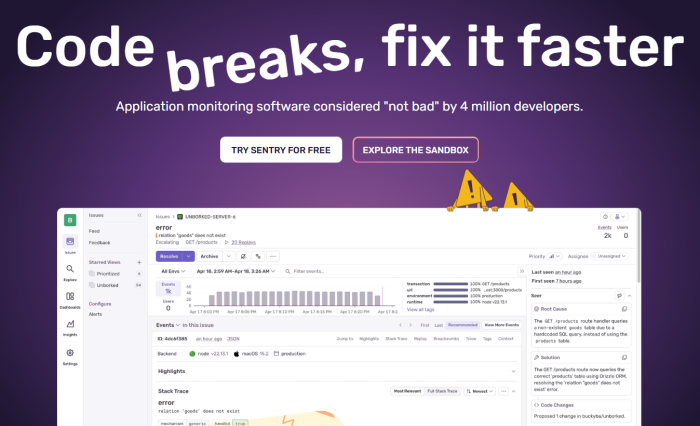
Known for:
Sentry is best known for application error and performance monitoring, especially among frontend and backend developers. It provides rich context for debugging issues in real time across JavaScript, Python, Ruby, Elixir, and mobile platforms.
Key Features:
- Error Tracking & Stack Traces
Automatically captures unhandled exceptions and logs detailed stack traces with user metadata, environment context, and breadcrumbs to help reproduce bugs. - Performance Monitoring
Provides lightweight distributed tracing for identifying slow API calls, long transactions, and UI latency. Built-in support for Web Vitals, Core Web Metrics, and transaction thresholds. - Session & User Insights
Sentry connects errors and performance data to individual sessions or user flows, enabling better prioritization and root cause analysis. - Release Health & Deployment Tracking
Visualizes crash-free sessions, release regressions, and deployment impacts on error rates or latency. - Integrations & SDKs
Robust SDK ecosystem supporting JavaScript, Python, Go, PHP, Java, Flutter, React Native, and more—alongside tools like GitHub, Jira, Slack, and Linear.
Standout Features:
- Deep error context and root cause detection
- Session replay (on higher-tier plans)
- Frontend performance instrumentation out of the box
- Source map support for minified JS debugging
Pros:
- Easy to integrate into most dev stacks
- Best-in-class error reporting and issue grouping
- Excellent frontend visibility, especially for JS-heavy apps
- Developer-friendly UI and workflow integration
Cons:
- Not a full observability platform (limited infrastructure/log coverage)
- Lacks native log aggregation or infrastructure metrics
- No support for OpenTelemetry
- Usage-based pricing can escalate with high error volumes
Best for:
Engineering teams focused on application-level debugging, frontend performance, or crash analysis—especially in web and mobile environments.
Pricing & Customer Reviews:
- Free tier includes basic error monitoring
- Team: $26/month, Business: $80/month, Enterprise: custom
- Pricing is event-based, which can scale quickly
G2 Rating: 4.4/5 — loved for debugging workflows, but limited for full-stack observability.
Sentry vs AppSignal:
Both tools cater to developers—but while AppSignal offers simple metrics + tracing across a few languages, Sentry goes much deeper into real-time error debugging, frontend performance, and user context. However, AppSignal includes logs and basic APM for backend services, whereas Sentry is more limited outside the application layer.
Conclusion
AppSignal’s limitations, including its basic trace UI, restricted language support, weak server tracking, limited error data export, and suboptimal Python OpenTelemetry integration, drive teams to seek robust alternatives. CubeAPM leads with OpenTelemetry-native, full-stack MELT support, smart sampling, and flexible hosting, offering a cost-effective, user-friendly solution for startups and enterprises. Dynatrace excels in AI-driven enterprise observability, while Coralogix optimizes log-heavy workflows with advanced data routing.
Why Choose CubeAPM?
CubeAPM outperforms AppSignal’s limited trace UI, restricted language support, and weak server tracking with an intuitive, AI-driven interface, broad language compatibility (e.g., Java, .NET, Rust), and robust monitoring in dynamic environments. Its advanced error tracking with exportable data and strong Python OTel integration, paired with full MELT support, RUM, and synthetics, surpass AppSignal and competitors like Dynatrace or New Relic. CubeAPM’s smart sampling and self-hosted options offer unmatched flexibility and simplicity for startups and enterprises.

